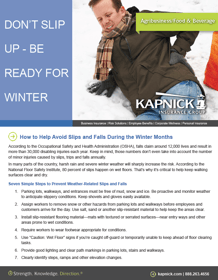HOW TO HELP AVOID SLIPS AND FALLS DURING THE WINTER MONTHS
According to the Occupational Safety and Health Administration (OSHA), falls claim around 12,000 lives and result in more than 30,000 disabling injuries each year. Keep in mind, those numbers don't even take into account the number of minor injuries caused by slips, trips and falls annually.
In many parts of the country, harsh rain and severe winter weather will sharply increase the risk. According to the National Floor Safety Institute, 80 percent of slips happen on wet floors. That's why it's critical to help keep walking surfaces clear and dry.
SEVEN SIMPLE STEPS TO PREVENT WEATHER-RELATED SLIPS AND FALLS
1. Parking lots, walkways, and entrances must be free of mud, snow and ice. Be proactive and monitor weather to anticipate slippery conditions. Keep shovels and gloves easily available.
2. Assign workers to remove snow or other hazards from parking lots and walkways before employees and customers arrive for the day. Use salt, sand or another slip-resistant material to help keep the areas clear.
3. Install slip-resistant flooring material — mats with textured or serrated surfaces — near entry ways and other areas prone to wet conditions.
4. Require workers to wear footwear appropriate for conditions.
5. Use "Caution: Wet Floor" signs if you're caught off-guard or temporarily unable to keep ahead of floor cleaning tasks.
6. Provide good lighting and clear path markings in parking lots, stairs and walkways.
7. Clearly identify steps, ramps and other elevation changes.
BUILD A FALL SAFETY CHECKLIST
- Set written standards for conditions of parking lots and walkways.
- Establish standards for the type of slip-resistant footwear and other safety gear that employees should wear and use.
- Define employee roles in preventing slips and falls. Share all guidelines with staff.
- Train employees — assigned to clearing lots and walkways — how to avoid back injuries and overexertion.
- Follow-up to assure fall prevention program standards are being met.
- Acknowledge success and make improvements where necessary.
HAVE A CONVERSATION WITH DRIVERS
Drivers getting in and out of vehicles are especially susceptible to falls. The risk rises substantially when mud, ice or snow are present. It's a risk faced by all drivers, but it's particularly high for operators of large trucks. Instruct your truck drivers to always use three points of contact while getting in and out of their cabs. (This means always keeping both hands on the vehicle for support as you raise or lower one leg at a time).
CONDUCT A WALK-THROUGH
Although winter weather presents a heightened risk for slips and falls due to wet floor surfaces, it's not the only factor. Spills can occur anywhere. Instruct all workers to clean up spills immediately. Also, have your safety committee conduct a walk-through of your entire operation to identify hazards while employees are working. The information gathered should be used to minimize each identified hazard.
CLICK THE IMAGE BELOW FOR A PRINTABLE VERSION OF THIS ARTICLE
Do you have a workplace safety program in place? Would you pass an OSHA inspection?
Contact us today and we will make sure your company stays compliant!
Did you see our previous OSHA Email about OSHA FINES? Check it out below!
888.263.4656 x1150 Amy DeKeyser | Risk Solutions Manager


